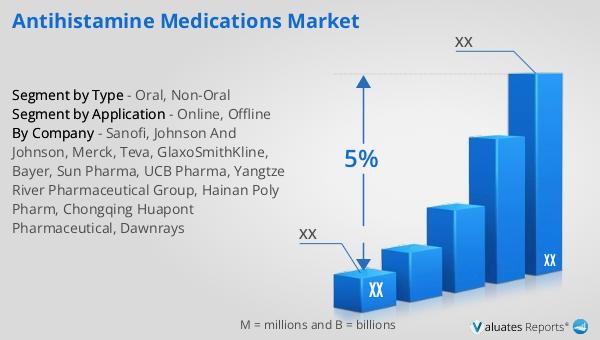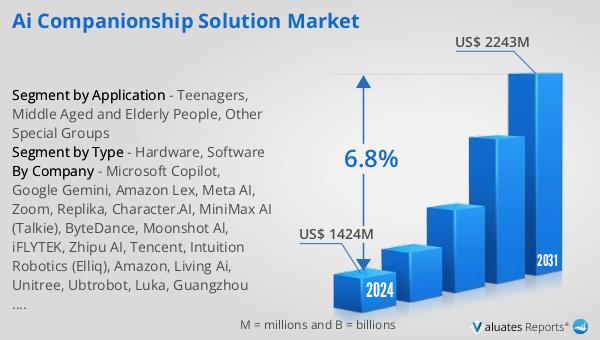What is Global Antihistamine Medications Market?
The Global Antihistamine Medications Market is a significant segment within the pharmaceutical industry, focusing on drugs that help alleviate symptoms caused by allergies. Antihistamines work by blocking histamine, a substance in the body that causes allergic symptoms. These medications are widely used to treat conditions such as hay fever, allergic rhinitis, conjunctivitis, and reactions to insect bites or stings. The market is driven by the increasing prevalence of allergies worldwide, which can be attributed to factors like pollution, changing lifestyles, and genetic predispositions. Additionally, the growing awareness about allergy management and the availability of over-the-counter antihistamine medications contribute to the market's expansion. The market encompasses various types of antihistamines, including first-generation and second-generation drugs, each with different efficacy and side effect profiles. As the demand for effective allergy treatments continues to rise, the Global Antihistamine Medications Market is expected to grow, offering numerous opportunities for pharmaceutical companies to innovate and expand their product offerings.

Oral, Non-Oral in the Global Antihistamine Medications Market:
In the Global Antihistamine Medications Market, antihistamines are available in various forms, primarily categorized into oral and non-oral medications. Oral antihistamines are the most common and widely used form, available in tablets, capsules, and liquid formulations. These medications are convenient for patients as they can be easily administered and are often available over-the-counter, making them accessible for self-medication. Oral antihistamines are effective in managing symptoms such as sneezing, itching, and runny nose associated with allergic reactions. They are further divided into first-generation and second-generation antihistamines. First-generation antihistamines, such as diphenhydramine and chlorpheniramine, are known for their sedative effects, which can be beneficial for nighttime allergy relief but may cause drowsiness during the day. Second-generation antihistamines, like loratadine and cetirizine, are less sedating and are preferred for daytime use due to their minimal impact on alertness. Non-oral antihistamines include nasal sprays, eye drops, and topical creams or ointments. Nasal sprays, such as azelastine and olopatadine, are particularly effective for treating nasal congestion and other symptoms of allergic rhinitis. They provide targeted relief by delivering the medication directly to the nasal passages, reducing systemic side effects. Eye drops, like ketotifen and olopatadine, are used to alleviate symptoms of allergic conjunctivitis, such as itchy and watery eyes. These non-oral formulations are beneficial for patients who experience localized symptoms or prefer not to take oral medications due to potential side effects or personal preferences. The choice between oral and non-oral antihistamines depends on various factors, including the severity and type of allergy symptoms, patient age, and individual response to medication. For instance, children and elderly patients may require specific formulations or dosages to ensure safety and efficacy. Additionally, some patients may have contraindications or allergies to certain antihistamine ingredients, necessitating alternative options. The availability of both oral and non-oral antihistamines in the market ensures that patients have access to a wide range of treatment options tailored to their specific needs. Pharmaceutical companies continue to invest in research and development to improve the efficacy and safety profiles of antihistamine medications. Innovations in drug delivery systems, such as sustained-release formulations and combination therapies, aim to enhance patient compliance and treatment outcomes. Furthermore, the increasing focus on personalized medicine is driving the development of targeted therapies that address the underlying causes of allergies, offering more effective and long-lasting relief for patients. In conclusion, the Global Antihistamine Medications Market offers a diverse array of oral and non-oral treatment options to manage allergy symptoms effectively. The choice of medication depends on individual patient needs and preferences, with both forms providing unique benefits and considerations. As the market continues to evolve, advancements in antihistamine therapies are expected to improve patient care and expand the range of available treatment options.
Online, Offline in the Global Antihistamine Medications Market:
The usage of Global Antihistamine Medications Market can be broadly categorized into online and offline channels, each offering distinct advantages and challenges. Online channels have gained significant traction in recent years, driven by the increasing adoption of e-commerce and digital health platforms. Consumers can conveniently purchase antihistamine medications from online pharmacies and retailers, often with the added benefit of home delivery. This is particularly advantageous for individuals with mobility issues or those living in remote areas with limited access to physical pharmacies. Online platforms also provide a wealth of information about different antihistamine products, allowing consumers to compare prices, read reviews, and make informed purchasing decisions. Additionally, the anonymity and privacy offered by online shopping can be appealing to consumers who prefer to keep their medical conditions confidential. However, the online purchase of antihistamine medications is not without challenges. Regulatory concerns regarding the sale of pharmaceuticals online, such as ensuring the authenticity and safety of products, remain a significant issue. Consumers must exercise caution and purchase medications only from reputable and licensed online pharmacies to avoid counterfeit or substandard products. Furthermore, the lack of face-to-face interaction with healthcare professionals can be a drawback for some consumers who may require guidance on the appropriate use of antihistamines or have questions about potential side effects and interactions with other medications. Offline channels, including brick-and-mortar pharmacies, supermarkets, and healthcare facilities, continue to play a crucial role in the distribution of antihistamine medications. These channels offer the advantage of immediate access to medications, allowing consumers to obtain relief from allergy symptoms without delay. Pharmacists and healthcare professionals are available to provide personalized advice and recommendations, ensuring that consumers select the most suitable antihistamine product for their needs. This face-to-face interaction is particularly valuable for individuals with complex medical histories or those taking multiple medications, as it allows for a comprehensive assessment of potential drug interactions and contraindications. Moreover, offline channels often provide a wider range of antihistamine products, including prescription-strength medications that may not be available online. This is especially important for patients with severe allergies or those who require specialized formulations. The physical presence of pharmacies and healthcare facilities also fosters a sense of trust and reliability among consumers, who may feel more confident purchasing medications from established and regulated entities. In summary, both online and offline channels play a vital role in the distribution and accessibility of antihistamine medications within the Global Antihistamine Medications Market. While online channels offer convenience and privacy, offline channels provide immediate access and personalized guidance from healthcare professionals. The coexistence of these channels ensures that consumers have multiple options for obtaining antihistamine medications, catering to diverse preferences and needs. As the market continues to evolve, the integration of digital technologies and innovative distribution strategies is expected to enhance the overall accessibility and efficiency of antihistamine medication delivery.
Global Antihistamine Medications Market Outlook:
The outlook for the Global Antihistamine Medications Market can be contextualized within the broader pharmaceutical industry trends. In 2022, the global pharmaceutical market was valued at approximately 1,475 billion USD, with an anticipated compound annual growth rate (CAGR) of 5% over the next six years. This growth trajectory underscores the expanding demand for pharmaceutical products, driven by factors such as an aging population, increasing prevalence of chronic diseases, and advancements in medical technology. Within this context, the chemical drug market, a significant component of the pharmaceutical industry, has also shown notable growth. From 2018 to 2022, the chemical drug market increased from 1,005 billion USD to 1,094 billion USD. This growth reflects the ongoing innovation and development of chemical-based medications, including antihistamines, which play a crucial role in managing various health conditions. The steady growth of the chemical drug market highlights the importance of continued investment in research and development to address emerging health challenges and meet the evolving needs of patients. As part of this broader market, the Global Antihistamine Medications Market is poised to benefit from these industry trends, with opportunities for pharmaceutical companies to expand their product portfolios and enhance the efficacy and safety of antihistamine treatments. The increasing awareness of allergy management and the availability of diverse antihistamine formulations further contribute to the market's potential for growth. In conclusion, the Global Antihistamine Medications Market is an integral part of the pharmaceutical industry, with a promising outlook driven by the broader trends in the chemical drug market. As the demand for effective allergy treatments continues to rise, the market is expected to offer numerous opportunities for innovation and expansion, ultimately improving patient care and outcomes.
| Report Metric | Details |
| Report Name | Antihistamine Medications Market |
| CAGR | 5% |
| Segment by Type |
|
| Segment by Application |
|
| Consumption by Region |
|
| By Company | Sanofi, Johnson And Johnson, Merck, Teva, GlaxoSmithKline, Bayer, Sun Pharma, UCB Pharma, Yangtze River Pharmaceutical Group, Hainan Poly Pharm, Chongqing Huapont Pharmaceutical, Dawnrays |
| Forecast units | USD million in value |
| Report coverage | Revenue and volume forecast, company share, competitive landscape, growth factors and trends |
